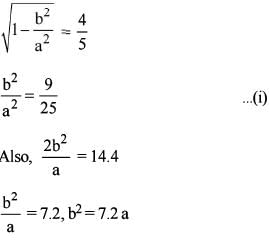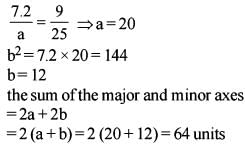Defence Exam > Defence Questions > What is the sum of the major and minor axes o...
Start Learning for Free
What is the sum of the major and minor axes of the ellipse whose eccentricity is 4/5 and length of latus rectum is 14.4 unit?
- a)32 units
- b)48 units
- c)64 units
- d)None of these
Correct answer is option 'C'. Can you explain this answer?
| FREE This question is part of | Download PDF Attempt this Test |
Verified Answer
What is the sum of the major and minor axes of the ellipse whose eccen...
Let 2a and 2b be the length of major and minor axis respectively.








Most Upvoted Answer
What is the sum of the major and minor axes of the ellipse whose eccen...
Given:
Eccentricity (e) = 4/5
Length of latus rectum (l) = 14.4 units
We know that the eccentricity (e) of an ellipse is given by the formula:
e = c/a
where c is the distance from the center of the ellipse to one of its foci, and a is the semi-major axis.
We also know that the length of the latus rectum (l) is given by the formula:
l = 2b^2/a
where b is the semi-minor axis.
To find the sum of the major and minor axes, we need to find the values of a and b.
Solving for a in the eccentricity formula:
e = c/a
4/5 = c/a
c = 4a/5
Substituting this value of c in the latus rectum formula:
l = 2b^2/a
14.4 = 2b^2/(4a/5)
14.4 = 10b^2/a
b^2 = (14.4a)/10
b = sqrt((14.4a)/10)
Now, we can substitute the value of b in the eccentricity formula to solve for a:
e = c/a
4/5 = (4a/5)/a
4/5 = 4/5
This equation is true for any value of a.
So, we can choose any value for a. Let's assume a = 5.
Substituting the value of a in the equation for b:
b = sqrt((14.4*5)/10)
b = sqrt(7.2)
b ≈ 2.683
Therefore, the semi-major axis (a) is 5 units and the semi-minor axis (b) is approximately 2.683 units.
Sum of major and minor axes:
= 2a + 2b
= 2(5) + 2(2.683)
= 10 + 5.366
= 15.366 units
Rounded to the nearest whole number, the sum of the major and minor axes is approximately 15 units.
Hence, the correct answer is option C.
Eccentricity (e) = 4/5
Length of latus rectum (l) = 14.4 units
We know that the eccentricity (e) of an ellipse is given by the formula:
e = c/a
where c is the distance from the center of the ellipse to one of its foci, and a is the semi-major axis.
We also know that the length of the latus rectum (l) is given by the formula:
l = 2b^2/a
where b is the semi-minor axis.
To find the sum of the major and minor axes, we need to find the values of a and b.
Solving for a in the eccentricity formula:
e = c/a
4/5 = c/a
c = 4a/5
Substituting this value of c in the latus rectum formula:
l = 2b^2/a
14.4 = 2b^2/(4a/5)
14.4 = 10b^2/a
b^2 = (14.4a)/10
b = sqrt((14.4a)/10)
Now, we can substitute the value of b in the eccentricity formula to solve for a:
e = c/a
4/5 = (4a/5)/a
4/5 = 4/5
This equation is true for any value of a.
So, we can choose any value for a. Let's assume a = 5.
Substituting the value of a in the equation for b:
b = sqrt((14.4*5)/10)
b = sqrt(7.2)
b ≈ 2.683
Therefore, the semi-major axis (a) is 5 units and the semi-minor axis (b) is approximately 2.683 units.
Sum of major and minor axes:
= 2a + 2b
= 2(5) + 2(2.683)
= 10 + 5.366
= 15.366 units
Rounded to the nearest whole number, the sum of the major and minor axes is approximately 15 units.
Hence, the correct answer is option C.

|
Explore Courses for Defence exam
|

|
Similar Defence Doubts
What is the sum of the major and minor axes of the ellipse whose eccentricity is 4/5 and length of latus rectum is 14.4 unit?a)32 unitsb)48 unitsc)64 unitsd)None of theseCorrect answer is option 'C'. Can you explain this answer?
Question Description
What is the sum of the major and minor axes of the ellipse whose eccentricity is 4/5 and length of latus rectum is 14.4 unit?a)32 unitsb)48 unitsc)64 unitsd)None of theseCorrect answer is option 'C'. Can you explain this answer? for Defence 2024 is part of Defence preparation. The Question and answers have been prepared according to the Defence exam syllabus. Information about What is the sum of the major and minor axes of the ellipse whose eccentricity is 4/5 and length of latus rectum is 14.4 unit?a)32 unitsb)48 unitsc)64 unitsd)None of theseCorrect answer is option 'C'. Can you explain this answer? covers all topics & solutions for Defence 2024 Exam. Find important definitions, questions, meanings, examples, exercises and tests below for What is the sum of the major and minor axes of the ellipse whose eccentricity is 4/5 and length of latus rectum is 14.4 unit?a)32 unitsb)48 unitsc)64 unitsd)None of theseCorrect answer is option 'C'. Can you explain this answer?.
What is the sum of the major and minor axes of the ellipse whose eccentricity is 4/5 and length of latus rectum is 14.4 unit?a)32 unitsb)48 unitsc)64 unitsd)None of theseCorrect answer is option 'C'. Can you explain this answer? for Defence 2024 is part of Defence preparation. The Question and answers have been prepared according to the Defence exam syllabus. Information about What is the sum of the major and minor axes of the ellipse whose eccentricity is 4/5 and length of latus rectum is 14.4 unit?a)32 unitsb)48 unitsc)64 unitsd)None of theseCorrect answer is option 'C'. Can you explain this answer? covers all topics & solutions for Defence 2024 Exam. Find important definitions, questions, meanings, examples, exercises and tests below for What is the sum of the major and minor axes of the ellipse whose eccentricity is 4/5 and length of latus rectum is 14.4 unit?a)32 unitsb)48 unitsc)64 unitsd)None of theseCorrect answer is option 'C'. Can you explain this answer?.
Solutions for What is the sum of the major and minor axes of the ellipse whose eccentricity is 4/5 and length of latus rectum is 14.4 unit?a)32 unitsb)48 unitsc)64 unitsd)None of theseCorrect answer is option 'C'. Can you explain this answer? in English & in Hindi are available as part of our courses for Defence.
Download more important topics, notes, lectures and mock test series for Defence Exam by signing up for free.
Here you can find the meaning of What is the sum of the major and minor axes of the ellipse whose eccentricity is 4/5 and length of latus rectum is 14.4 unit?a)32 unitsb)48 unitsc)64 unitsd)None of theseCorrect answer is option 'C'. Can you explain this answer? defined & explained in the simplest way possible. Besides giving the explanation of
What is the sum of the major and minor axes of the ellipse whose eccentricity is 4/5 and length of latus rectum is 14.4 unit?a)32 unitsb)48 unitsc)64 unitsd)None of theseCorrect answer is option 'C'. Can you explain this answer?, a detailed solution for What is the sum of the major and minor axes of the ellipse whose eccentricity is 4/5 and length of latus rectum is 14.4 unit?a)32 unitsb)48 unitsc)64 unitsd)None of theseCorrect answer is option 'C'. Can you explain this answer? has been provided alongside types of What is the sum of the major and minor axes of the ellipse whose eccentricity is 4/5 and length of latus rectum is 14.4 unit?a)32 unitsb)48 unitsc)64 unitsd)None of theseCorrect answer is option 'C'. Can you explain this answer? theory, EduRev gives you an
ample number of questions to practice What is the sum of the major and minor axes of the ellipse whose eccentricity is 4/5 and length of latus rectum is 14.4 unit?a)32 unitsb)48 unitsc)64 unitsd)None of theseCorrect answer is option 'C'. Can you explain this answer? tests, examples and also practice Defence tests.

|
Explore Courses for Defence exam
|

|
Signup for Free!
Signup to see your scores go up within 7 days! Learn & Practice with 1000+ FREE Notes, Videos & Tests.


















